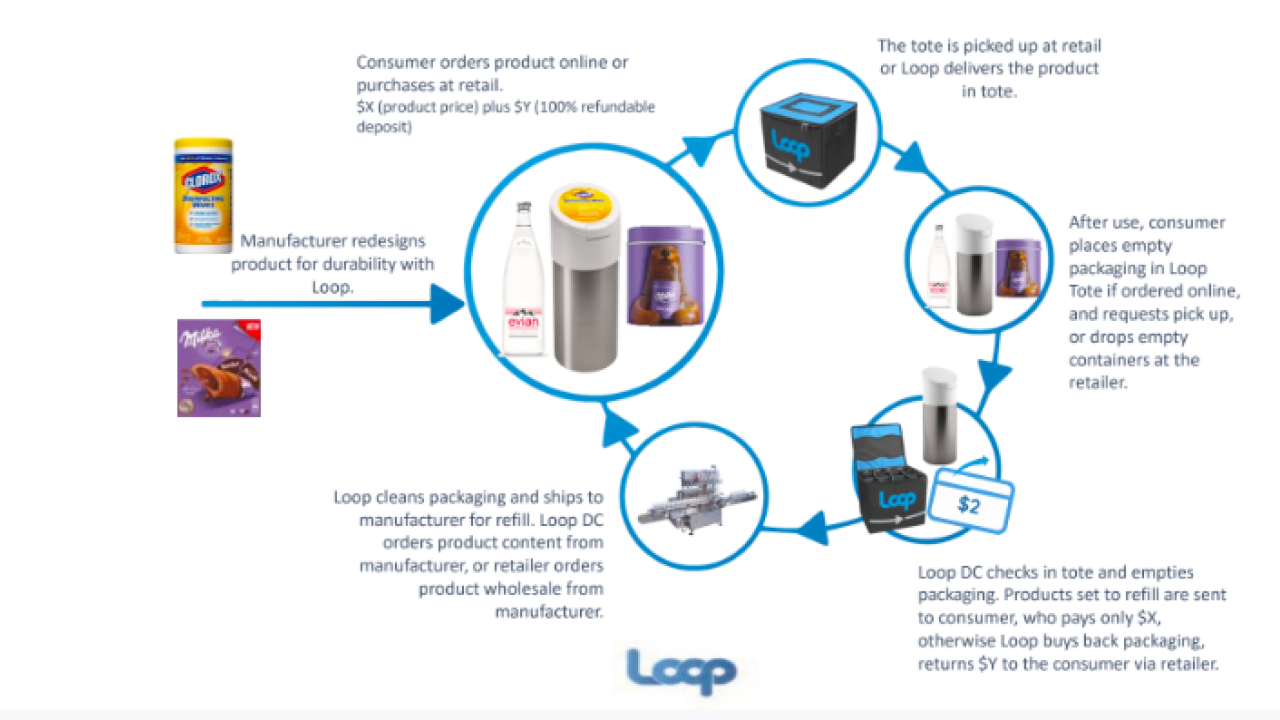The green column: TerraCyle’s Loop to shift single-use packaging paradigm

Packaging and product manufacturers are well aware of the environmental impact of their companies, the negative press about single-use plastics in our oceans, consumer demand for more sustainable solutions, recycling rates with room for improvement and jam-packed landfills. TerraCycle, the globally known leader in recycling hard-to-recycle waste, such as laminated snack pouches, toothbrushes and polyurethane earplugs, is blazing yet another trail, this time wholly changing the way we think about products and consumption to support our value stream in reducing its reliance on single-use packaging.
This year TerraCycle has launched Loop, a circular packaging reuse solution that changes the existing model for fast moving consumer goods. Loop has created an infrastructure where the primary product containers are durable, designed for multiple uses. The containers are collected, cleaned, refilled and reused via e-commerce and retail, making reuse convenient and affordable to customers through virtual and physical shopping channels.
Today a package is considered a COGS (cost of goods sold), and its cost is fully allocated per fill. The cheaper the package the lower the cost per fill. In the Loop model, the package is property of the CPG company rather than the consumer. In this way, the manufacturer’s allocation per fill is the cost divided by the number of uses it can bear. The more durable the package, the lower the cost per fill. By changing the concept around ownership, the demand for durability increases.
Rick Zultner, vice president of research and development at Loop, says: ‘When the packaging is an asset to the brand, and made as durable as possible, the manufacturer can depreciate the cost over time. In the current model, single-use packaging is effectively hurting the bottom line, and there is more incentive to reduce the cost per unit as much as possible.’
The incentive to reduce the cost per unit is part of what makes hard-to-recycle laminated pouches so appealing, coupled with convenience and ease-of-use. Therefore, the underlying benefit to the Loop model is the economic structure with the ultimate incentive of eliminating single-use waste entirely. We have a long way to go before we start seeing a major shift, but there’s no doubt that global consumers are eager for a viable, sustainable consumption option such as Loop.
Zultner continues: ‘There is a healthy amount of market development being done, and we know that this model makes sense to better align the total life-cycle cost of a product with the finance objectives of the company manufacturing the products.’
The circular Loop
Loop offers its reuse packaging system using two models. For e-commerce convenience, brands can integrate their product onto the Loop website. Loop executes all receiving, outbound distribution, inbound distribution and cleaning. The second option is to purchase products at Loop retail partners’ brick and mortar locations. Once the consumer is finished with the product, they can return it to the retail store. The consumer will receive their deposit back, and the empties will be transported through the grocery store distribution network back to Loop for cleaning and refilling. For initial launch, only the e-commerce option is available.
In the US, UPS is Loop’s logistics partner, handling delivery and reverse logistics. Together the partners custom-designed the foldable Loop tote to handle liquids, dry goods and personal care products with protective dividers inside, using materials that offer easy cleaning. The UPS Package Design and Test Lab identified ways to mitigate material breakdown, product leaks and exterior packaging materials that display dilapidation quickly. The tote eliminates the need for the ubiquitous corrugated boxes we have become so familiar with as e-commerce users.
The tote comes with a shipping label to place on the top of the tote when the containers are empty and ready to be returned. Users trigger return pick up and shipment through their account on the website.
Throwback ‘milkman’ designs
Loop assists product manufacturers with the selection of their primary container materials including aluminum, stainless steel, glass and engineered plastic. Zultner explains: ‘We want to make sure the containers can be cleaned and effectively reused.’
Material selection is based on the product type and where in the household the product is used. For example, Love Beauty and Planet’s shampoo bottles are aluminum because of the hazard associated with breaking. However, REN Clean Skincare’s bottles are glass.
Designs from the 1950s have made a comeback with this paradigm shift, harking back to a time where there was no concept around single-use and disposal. For example, Mondelez’s Milka brand is going back to a design more like a cookie tin from the post-war era.
Manufacturers are starting small and incubating their most prominent brands using the Loop circular opportunity. Most of the Loop participants have R&D lines to do the filling in-house, or the ability to contract with a specialty filler.
The objective is to design a primary container that can withstand 100 uses at a minimum. Explains Zultner: ‘In a life-cycle analysis, depending on the type of package – if it can achieve five uses, it’s considered better than single-use packaging, and any uses beyond that deliver both environmental and cost savings.’
Branding durable containers
Much of the growth in the label industry through the 1970s and 1980s can be attributed to the increasing demand for foods, beverages and beauty products in convenient, single-use packaging. According to Forbes, humans buy a million plastic bottles every minute; and it’s estimated that over half a trillion plastic bottles will be sold in 2020.
Loop has officially launched in the greater Paris area, and New York state, New Jersey, and Pennsylvania – all locations within a one-day shipping zone. Should these regional consumers shift their buying power even a small percentage to Loop’s reusable containers, the label industry will feel the contraction.
The Loop teams are actively researching the best decoration technologies to suit the purpose of reuse on these durable containers. Zultner says: ‘We’ll need labels that remain appealing through multiple washing stages, but can be peeled off and removed without damaging the packaging and without leaving residue behind.’
Loop is looking to build a materials guide for its CPG partners, informing users on adhesive and material selection to meet their branding objectives. For instance, the adhesive and overall durability of a label on the front of the container might require more permanence than the back label, to accommodate more frequent ingredient changes during a reuse phase. Alternatively, the front of the container could incorporate direct print while only the ingredient label is pressure-sensitive and can be effectively removed frequently for updates.
‘It’s still important for brands to differentiate their products through the Loop platform,’ Zultner says. ‘And we’ll be using our resources to help uncover the best ways of branding and labeling the primary containers used in the Loop infrastructure.’
Brand participation
The Clorox Company’s Hidden Valley Ranch dressing, Unilever’s Hellman’s mayonnaise and Nestlé’s Haagen-Dazs ice cream are among the participating food brands. Terracycle has targeted the largest food conglomerates to get involved. Says Zultner: ‘It adds momentum to the initiative and can help change the entire market direction.’ With the right brand participation, Loop can more rapidly gain authority and relevance in the marketplace.
Moreover, Unilever’s power brands Dove, Axe, Love Beauty and Planet, REN Clean Skincare, and Seventh Generation are available through Loop. Procter & Gamble’s influential brands Pantene, Tide, Cascade and Crest can be purchased with reusable packaging via Loop.
The opportunity TerraCycle’s Loop offers is exciting and telling in many ways about the pivotal way packaging sustainability will evolve over the next 10-15 years, or sooner. So many consumers are already heavily entrenched in today’s e-commerce infrastructure. It’s only a matter of time before leading brands participating in Loop gain user traction, achieve growth and find renewed cost models that make their businesses more profitable.
In turn CPG shareholders will be more confident, and CPG customers happier about the economic and environmental decisions they’re able to make when purchasing their favorite products. Wise label converters will pay attention to the moves their customers are making in the packaging reuse space, so they can continue servicing their needs in a 21st century milkman’s world.
Stay up to date
Subscribe to the free Label News newsletter and receive the latest content every week. We'll never share your email address.


